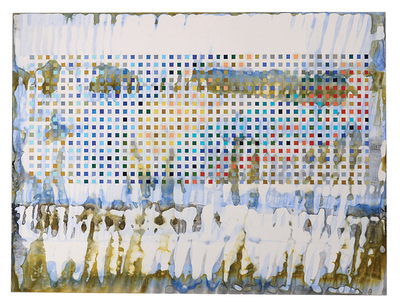Robert Paasch: Reality Duality

Robert Paasch, Open Blockgrid Rectangle #36, 2002, oil, acrylic and India Ink on clay panel, 18 x 24″.
The grid casts a long, symmetrical shadow over contemporary art. Piet Mondrian was one of the first, and most well known, adopters. Agnes Martin and Sol LeWitt were later disciples of the carefully plotted square. Add to this lineage New York painter Robert Paasch, whose grid-employing Reality Duality is the third offering from Periphery, a project space/gallery run by Rhode Island artist Barbara ‘Babs’ Owen.
The paintings in the Open Block Grid series “attempt to visually address the idea of the mind superimposing its convictions onto nature,” Paasch writes. To conjure this overlapping set of perceptions, he layers pixilated rows of color atop less definite, and more expressionist, grounds of murky, smoky, clouded color. While Kazimir Malevich intended spiritual awe through his geometries, Paasch’s formula owes more to the mathematician than the saint.
His grids instead define “the act of mental compartmentalization,” while the ground is “raw, unfiltered reality.” Rather than the grid as transit to heaven, the presence of more chaotic backdrops suggests the grid as a beautifying effort to harness and classify. Like a barrier against the wilderness, the sequential squares can only float atop reality, not puncture it. As Paasch notes this is still a remarkably effective filter: “We don’t see what is, but what we choose to see.”
Audiences will want to see Paasch’s skillfully painted squares, as well as the viscous, gooey ether of the settings they bleep and blip against. Paasch plots his pretty, twinkling grids like a puzzle or game. Ideally, each color does not appear next to itself, and each is repeated the same number of times. It’s not always successful —but, Paasch notes, neither is solitaire. The backgrounds also get to play: their palettes inform the grid’s color schemes.
Paasch’s communications from the gridded world are still beholden to some measure of order. Why use a grid if not to invoke —or, better yet, question— order? The power of Paasch’s grids derives from the fundamental tensions of abstraction: perfect form versus spontaneous expression, rationalism versus mysticism, and the controllability of art versus the unadulterated messiness of life.
